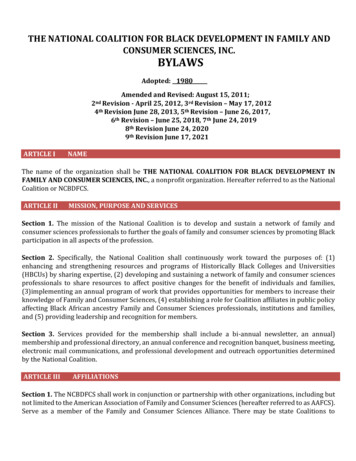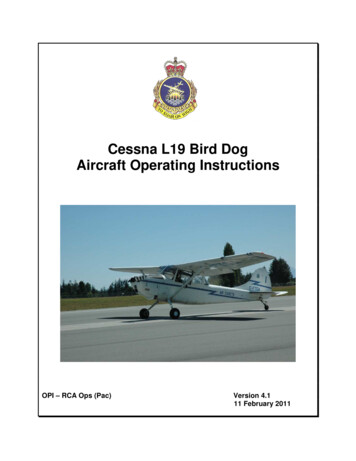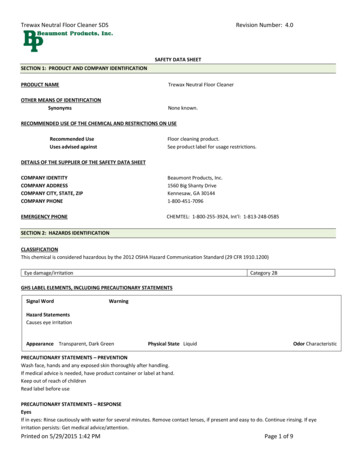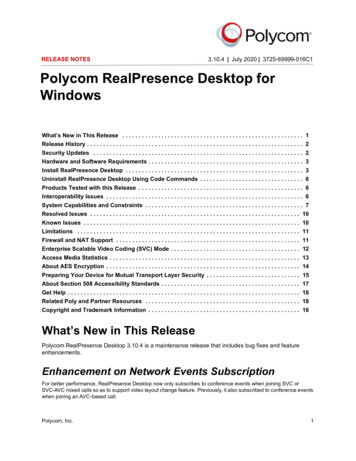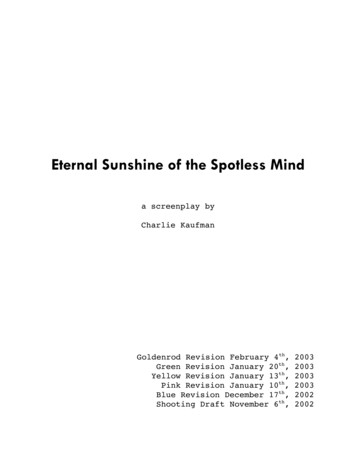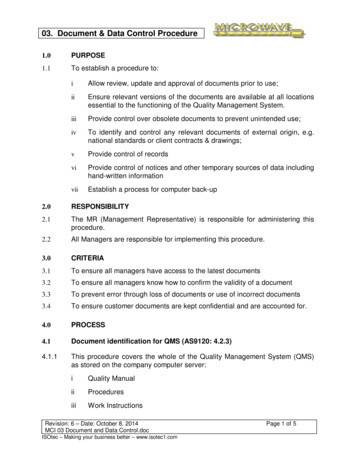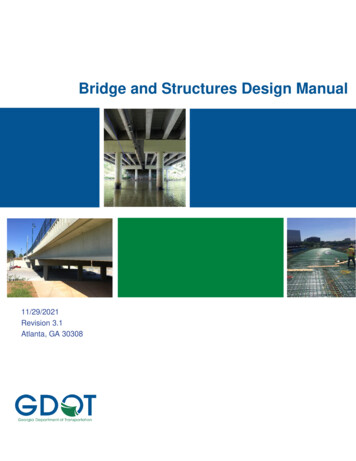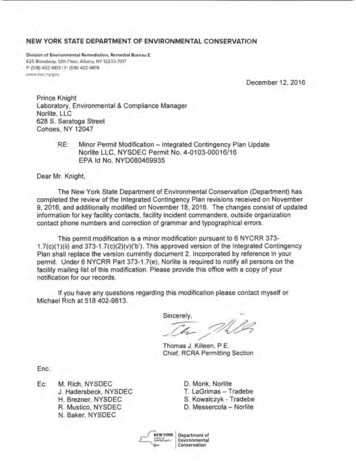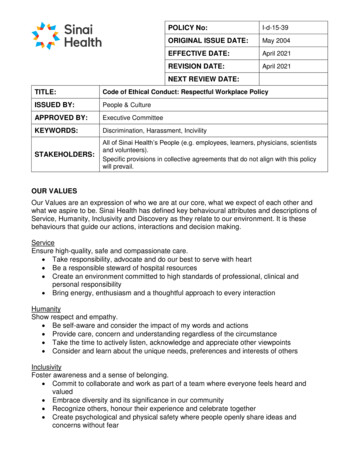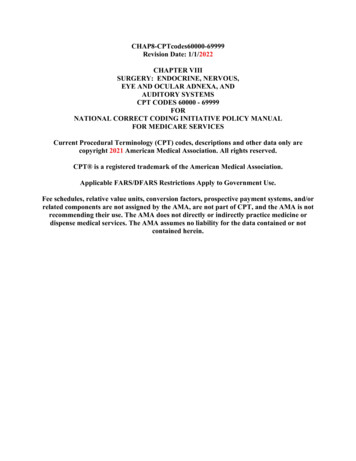
Transcription
CHAP8-CPTcodes60000-69999Revision Date: 1/1/2022CHAPTER VIIISURGERY: ENDOCRINE, NERVOUS,EYE AND OCULAR ADNEXA, ANDAUDITORY SYSTEMSCPT CODES 60000 - 69999FORNATIONAL CORRECT CODING INITIATIVE POLICY MANUALFOR MEDICARE SERVICESCurrent Procedural Terminology (CPT) codes, descriptions and other data only arecopyright 2021 American Medical Association. All rights reserved.CPT is a registered trademark of the American Medical Association.Applicable FARS/DFARS Restrictions Apply to Government Use.Fee schedules, relative value units, conversion factors, prospective payment systems, and/orrelated components are not assigned by the AMA, are not part of CPT, and the AMA is notrecommending their use. The AMA does not directly or indirectly practice medicine ordispense medical services. The AMA assumes no liability for the data contained or notcontained herein.
Table of ContentsChapter VIII . VIII-3Surgery: Endocrine, Nervous, Eye and Ocular Adnexa, and Auditory Systems . VIII-3CPT Codes 60000-69999 . VIII-3A. Introduction . VIII-3B. Evaluation & Management (E&M) Services . VIII-3C. Nervous System. VIII-4D. Ophthalmology. VIII-11E. Auditory System . VIII15F. Operating Microscope . VIII-15G. Laparoscopy . VIII-16H. Medically Unlikely Edits (MUEs) . VIII-17I. General Policy Statements . VIII-18Revision Date (Medicare): 1/1/2022VIII-2
Chapter VIIISurgery: Endocrine, Nervous, Eye and Ocular Adnexa, and Auditory SystemsCPT Codes 60000-69999A. IntroductionThe principles of correct coding discussed in Chapter I apply to the Current ProceduralTerminology (CPT) codes in the range 60000-69999. Several general guidelines are repeated inthis Chapter. However, those general guidelines from Chapter I not discussed in this chapter arenonetheless applicable.Providers/suppliers shall report the Healthcare Common Procedure Coding System/CurrentProcedural Terminology (HCPCS/CPT) code that describes the procedure performed to thegreatest specificity possible. A HCPCS/CPT code shall be reported only if all services describedby the code are performed. A provider/supplier shall not report multiple HCPCS/CPT codes if asingle HCPCS/CPT code exists that describes the services. This type of unbundling is incorrectcoding.HCPCS/CPT codes include all services usually performed as part of the procedure as a standardof medical/surgical practice. A provider/supplier shall not separately report these services simplybecause HCPCS/CPT codes exist for them.Specific issues unique to this section of CPT are clarified in this chapter.B. Evaluation & Management (E&M) ServicesMedicare Global Surgery Rules define the rules for reporting Evaluation & Management (E&M)services with procedures covered by these rules. This section summarizes some of the rules.All procedures on the Medicare Physician Fee Schedule are assigned a global period of 000, 010,090, XXX, YYY, ZZZ, or MMM. The global concept does not apply to XXX procedures. Theglobal period for YYY procedures is defined by the Medicare Administrative Contractor (MAC).All procedures with a global period of ZZZ are related to another procedure, and the applicableglobal period for the ZZZ code is determined by the related procedure. Procedures with a globalperiod of MMM are maternity procedures.Since National Correct Coding Initiative (NCCI) Procedure-to-Procedure (PTP) edits are appliedto same day services by the same provider/supplier to the same beneficiary, certain GlobalSurgery Rules are applicable to the NCCI program. An E&M service is separately reportable onthe same date of service as a procedure with a global period of 000, 010, or 090 days underlimited circumstances.If a procedure has a global period of 090 days, it is defined as a major surgical procedure. If anE&M service is performed on the same date of service as a major surgical procedure for thepurpose of deciding whether to perform this surgical procedure, the E&M service is separatelyreportable with modifier 57. Other preoperative E&M services on the same date of service as amajor surgical procedure are included in the global payment for the procedure and are notRevision Date (Medicare): 1/1/2022VIII-3
separately reportable. The NCCI program does not contain edits based on this rule becauseMACs have separate edits.If a procedure has a global period of 000 or 010 days, it is defined as a minor surgical procedure.In general, E&M services on the same date of service as the minor surgical procedure areincluded in the payment for the procedure. The decision to perform a minor surgical procedure isincluded in the payment for the minor surgical procedure and shall not be reported separately asan E&M service. However, a significant and separately identifiable E&M service unrelated tothe decision to perform the minor surgical procedure is separately reportable with modifier 25.The E&M service and minor surgical procedure do not require different diagnoses. If a minorsurgical procedure is performed on a new patient, the same rules for reporting E&M servicesapply. The fact that the patient is “new” to the provider/supplier is not sufficient alone to justifyreporting an E&M service on the same date of service as a minor surgical procedure. The NCCIprogram contains many, but not all, possible edits based on these principles.For major and minor surgical procedures, postoperative E&M services related to recovery fromthe surgical procedure during the postoperative period are included in the global surgicalpackage as are E&M services related to complications of the surgery. Postoperative visitsunrelated to the diagnosis for which the surgical procedure was performed unless related to acomplication of surgery may be reported separately on the same day as a surgical procedure withmodifier 24 (“Unrelated Evaluation and Management Service by the Same Physician or OtherQualified Health Care Professional During a Postoperative Period”).Procedures with a global surgery indicator of “XXX” are not covered by these rules. Many ofthese “XXX” procedures are performed by physicians and have inherent pre-procedure, intraprocedure, and post-procedure work usually performed each time the procedure is completed.This work shall not be reported as a separate E&M code. Other “XXX” procedures are notusually performed by a physician and have no physician work relative value units associatedwith them. A provider/supplier shall not report a separate E&M code with these procedures forthe supervision of others performing the procedure or for the interpretation of the procedure.With most “XXX” procedures, the physician may, however, perform a significant and separatelyidentifiable E&M service that is above and beyond the usual pre- and post-operative work of theprocedure on the same date of service which may be reported by appending modifier 25 to theE&M code. This E&M service may be related to the same diagnosis necessitating performanceof the “XXX” procedure but cannot include any work inherent in the “XXX” procedure,supervision of others performing the “XXX” procedure, or time for interpreting the result of the“XXX” procedure.C. Nervous System1.A burr hole is often necessary for intracranial surgery (e.g., craniotomy,craniectomy) to access intracranial contents, to alleviate pressure, or to place an intracranialpressure monitoring device. When this service is integral to the performance of other services,CPT codes describing this service are not separately reportable if performed at the same patientencounter. A burr hole is separately reportable with another cranial procedure only if performedRevision Date (Medicare): 1/1/2022VIII-4
at a separate site unrelated to the other cranial procedure or at a separate patient encounter on thesame date of service.In addition, taps, punctures, or burr holes accompanied by drainage procedures (e.g., hematoma,abscess, cyst, etc.) followed by other procedures are not separately reportable unless performedas staged procedures. Modifier 58 may be reported to indicate staged or planned services. Manyintracranial procedures include bone grafts by CPT definition, and these grafts should not bereported separately.2.Biopsies performed in the course of Central Nervous System (CNS) surgery shallnot be reported as separate procedures. See Chapter VIII, Section I, Subsection 10 (GeneralPolicy Statements), for further information regarding biopsies.3.Craniotomies and craniectomies always include a general exploration of theaccessible field. An exploratory craniectomy or craniotomy (CPT code 61304 or 61305) shall notbe reported separately with another craniectomy/craniotomy procedure performed at the sameanatomic site and same patient encounter.4.A craniotomy is performed through a skull defect resulting from reflection of askull flap. Replacing the skull flap during the same procedure is an integral component of acraniotomy procedure and shall not be reported separately using the cranioplasty CPT codes62140 and 62141. A cranioplasty may be separately reportable with a craniotomy procedure ifthe cranioplasty is performed to replace a skull bone flap removed during a procedure at a priorpatient encounter or if the cranioplasty is performed to repair a skull defect larger than thatcreated by the bone flap.5.If 2 procedures are performed at the same anatomic site and same patientencounter, 1 procedure may be bundled into the other (e.g., 1 procedure may be integral to theother). However, if the 2 procedures are performed at separate anatomic sites or at separatepatient encounters, they may be separately reportable. Modifiers 59 or -X{ES} may be reportedto indicate that the 2 procedures are distinct and separately reportable services under thesecircumstances.ExampleA patient with an open head injury and a contre-coup subdural hematoma requires an exploratorycraniectomy for the open head injury and a burr hole drainage on the contralateral side for asubdural hematoma. The creation of a burr hole at the site of the exploratory craniectomy wouldbe considered integral to the craniectomy. However, the contralateral burr hole drainage is aseparate service not integral to the exploratory craniectomy. To correctly report the burr holedrainage for the contralateral subdural hematoma and the exploratory craniectomy, the burr holeshould be reported with the appropriate modifier. In this example, the correct coding would beCPT codes 61304 (Exploratory craniectomy) with one unit of service and 61154 (Burr hole withdrainage of subdural hematoma) -59 or -X{ES}with one unit of service.6.If a physician performs a craniectomy or craniotomy procedure and places aventricular catheter, pressure recording device, or other intracerebral monitoring device throughRevision Date (Medicare): 1/1/2022VIII-5
the same hole in the skull, the provider/supplier shall not separately report CPT code 61107(Twist drill hole(s) for subdural, intracerebral, or ventricular puncture; for implanting ventricularcatheter.monitoring device). CPT code 61107 may be reported separately with an NCCI PTPassociated modifier if it is necessary to place a ventricular catheter, pressure recording device, orother intracerebral monitoring device through a different hole in the skull.7.If a physician evacuates, aspirates, or drains an intracranial hematoma (e.g., CPTcodes 61154, 61156, 61312-61315), the provider/supplier shall not separately report a code fordrainage of a hematoma in the overlying skin to access the intracranial hematoma. Accessthrough diseased tissue to perform a more extensive definitive procedure is not separatelyreportable.8.CPT codes 61781-61783 are Add-on Codes (AOCs) describing computer-assistednavigational procedures of the cranium or spine. CMS payment policy does not allow CPT code69990 (Microsurgical technique requiring use of operating microscope) to be reported with thesecodes unless CPT code 69990 is reported with another CPT code that meets the requirements ofthe Centers of Medicare & Medicaid Services (CMS) “Internet-Only Manual”, Publication 10004, “Medicare Claims Processing Manual”, Chapter 12 (Physicians/Nonphysician Practitioners),Section 20.4.5. This “IOM” section limits the separate payment for CPT code 69990 to a smallnumber of procedures. In these situations, providers/suppliers may report modifier 59 or XUwith CPT code 69990 to indicate that the procedure described by CPT code 69990 wasperformed for a procedure other than the computer-assisted navigation on the same date ofservice.9.The use of general intravascular access devices (e.g., intravenous lines), cardiacmonitoring, oximetry, laboratory sample procurement, and other routine monitoring for patientsafety during general anesthesia, monitored anesthesia care, or other anesthesia are included inthe anesthesia service and are not separately reportable. For example, if a physician performing aspinal puncture for intrathecal injection administers an anxiolytic agent, the vascular access andany appropriate monitoring is considered part of the spinal puncture procedure and is notseparately reportable.10.When a spinal puncture is performed, the local anesthesia necessary to performthe spinal puncture is included in the procedure. The reporting of nerve block or facet block CPTcodes for anesthesia for a diagnostic or therapeutic lumbar puncture is inappropriate.11.If cerebrospinal fluid is withdrawn during a nerve block procedure, thewithdrawal is not separately reportable (e.g., diagnostic lumbar puncture). It is integral to thenerve block procedure.12.If a dural (cerebrospinal fluid) leak occurs during a spinal procedure, repair of thedural leak is integral to the spinal procedure. CPT code 63707 or 63709 (Repair ofdural/cerebrospinal fluid leak) shall not be reported separately for the repair.If a dural (cerebrospinal fluid) leak occurs during a skull base approach procedure, repair of thedural leak is integral to the skull base approach procedure. CPT code 61618 or 61619 (SecondaryRevision Date (Medicare): 1/1/2022VIII-6
repair of dura for cerebrospinal fluid leak) shall not be reported separately for the repair.If a dural (cerebrospinal fluid) leak occurs during a burr hole, craniotomy, or craniectomyprocedure, repair of the dural leak is integral to the burr hole, craniotomy, or craniectomyprocedure. CPT code 62100 (Craniotomy for repair of dural/cerebrospinal fluid leak) shall not bereported separately for the repair.13.CPT code 29848 describes endoscopic release of the transverse carpal ligament ofthe wrist. CPT code 64721 describes a neuroplasty and/or transposition of the median nerve atthe carpal tunnel and includes open release of the transverse carpal ligament. The procedurecoded as CPT code 64721 includes the procedure coded as CPT code 29848 when performed onthe same wrist at the same patient encounter. If an endoscopic procedure is converted to an openprocedure, only the open procedure may be reported.14.Nerve repairs by suture (neurorrhaphies) (CPT codes 64831-64876) includesuture and anastomosis of nerves when performed to correct traumatic injury or anastomosis ofnerves which are proximally associated (e.g., facial-spinal accessory, facial-hypoglossal, etc.).When neurorrhaphy is performed with a nerve graft (CPT codes 64885-64913), neuroplasty,transection, excision, neurectomy, excision of neuroma, etc., the neurorrhaphy is integral to theprocedure and is not separately reportable.15.Implantation of neurostimulator electrodes in an area of the cerebral cortex maynot be reported with two codes describing different approaches. CPT code 61860 describesimplantation by craniectomy or craniotomy. CPT code 61850 describes implantation by twistdrill or burr hole(s).16.CPT codes 61885, 61886, and 63685 describe “insertion or replacement” ofcranial or spinal neurostimulator pulse generators or receivers. Reporting an “insertion orreplacement” CPT code necessitates use of a new neurostimulator pulse generator or receiver.CPT codes 61888 and 63688 describe “revision or removal” of cranial or spinal neurostimulatorpulse generators or receivers. If the same pulse generator is removed and replaced into the sameor another skin pocket, the “revision” CPT code is the only CPT code that may be reported. The“replacement” CPT code which requires use of a new neurostimulator pulse generator or receivershall not be reported as this Manual previously indicated. If one pulse generator is removed andreplaced with a different pulse generator into the same or another skin pocket, the “replacement”CPT code may be reported. The “removal” CPT code is not separately reportable. The “insertionor replacement” CPT code is separately reportable with a “revision or removal” CPT code only if2 separate batteries/generators are changed. For example, if one battery/generator is replaced(e.g., right side) and another is removed (e.g., left side), CPT codes for the “insertion orreplacement” and “revision or removal” could be reported together with modifier 59 or XU.17.Because procedures necessary to perform a Column One coded procedure areincluded in the Column One coded procedure, Column Two CPT codes such as 62320-62327(Injection of diagnostic or therapeutic substances) are included in the codes describing moreinvasive spinal/back procedures.Revision Date (Medicare): 1/1/2022VIII-7
18.A laminectomy includes excision of all the posterior vertebral components, and alaminotomy includes partial excision of posterior vertebral components. Since a laminectomy isa more extensive procedure than a laminotomy, a laminotomy code shall not be reported with alaminectomy code for the same vertebra. CPT codes 22100-22103 (partial excision of posteriorvertebral component (e.g., spinous process, lamina, or facet) for intrinsic bony lesion) are notseparately reportable with laminectomy or laminotomy procedures for the same vertebra.19.Some spinal procedures may require manipulation of the spine which is integral tothe procedure. CPT code 22505 (Manipulation of spine requiring anesthesia, any region) shallnot be reported separately with a spinal procedure.20.Fluoroscopy reported as CPT code 76000 shall not be reported with spinalprocedures unless there is a specific “CPT Manual” instruction indicating that it is separatelyreportable. For some spinal procedures there are specific radiologic guidance codes to report inlieu of these fluoroscopy codes. For other spinal procedures, fluoroscopy is used in lieu of amore traditional intraoperative radiologic examination which is included in the operativeprocedure. For other spinal procedure codes, fluoroscopy is integral to the procedure. (CPT code76001 was deleted January 1, 2019.)21.CPT codes 62321, 62323, 62325, and 62327 describe injections of diagnostic ortherapeutic substance(s) into the epidural or subarachnoid spaces at different spinal levels withfluoroscopic or CT guidance. Fluoroscopic guidance such as CPT code 77003 (Fluoroscopicguidance and localization of needle or catheter tip for spine or paraspinous diagnostic ortherapeutic injection procedures (epidural or subarachnoid)) is included in these procedures andshould not be reported separately with these codes.On January 1, 2017, CPT codes 62310-62319 were replaced by CPT codes 62320-62327. CPTcodes 62321, 62323, 62325, and 62327 describe these injections with fluoroscopic or CTguidance, and CPT codes 62320, 62322, 62324, and 62326 describe these injections withoutimaging guidance.22.Many spinal procedures are grouped into families of codes where there areseparate primary procedure codes describing the procedure at a single vertebral level in thecervical, thoracic, or lumbar region of the spine. Within some families of codes there is an AOCfor reporting the same procedure at each additional level without specification of the spinalregion for the AOC. When multiple procedures from one of these families of codes areperformed at contiguous vertebral levels, a provider/supplier shall report only one primary codewithin the family of codes for one level and shall report additional contiguous levels using theAOC(s) in the family of codes. The reported primary code should be the one corresponding tothe spinal region of the first procedure. If multiple procedures from one of these families ofcodes are performed through separate skin incisions at multiple vertebral levels that are notcontiguous and in different regions of the spine, the provider/supplier may report one primarycode for each non-contiguous region.For example, the family of CPT codes 22532-22534 describes arthrodesis by lateral extracavitarytechnique. CPT code 22532 describes the procedure for a single thoracic vertebral segment. CPTRevision Date (Medicare): 1/1/2022VIII-8
code 22533 describes the procedure for a single lumbar vertebral segment. CPT code 22534 is anAOC describing the procedure for each additional thoracic or lumbar vertebral segment. If aphysician performs arthrodesis by lateral extracavitary technique on contiguous vertebralsegments such as T12 and L1, only one primary procedure code, the one for the first procedure,may be reported. The procedure on the second vertebral body may be reported with CPT code22534. If a physician performs the procedure at T10 and L4 through separate skin incisions, theprovider/supplier may report CPT codes 22532 and 22533.CPT codes 22510-22512 represent a family of codes describing percutaneous vertebroplasty, andCPT codes 22513-22515 represent a family of codes describing percutaneous vertebralaugmentation. Within each of these families of codes, the provider/supplier may report only oneprimary procedure code and the add-on procedure code for each additional level(s) whether theadditional level(s) are contiguous or not.23.CPT codes 22600-22614 describe arthrodesis by posterior or posterolateraltechnique. CPT codes 22630-22632 describe arthrodesis by posterior interbody technique. CPTcodes 22633-22634 describe arthrodesis by combined posterior or posterolateral technique withposterior interbody technique. These codes are reported per level or interspace. CPT code 22614is an AOC that may be reported with primary CPT codes 22600, 22610, 22612, 22630, or 22633.CPT code 22632 is an AOC that may be reported with primary CPT codes 22612, 22630, or22633. CPT code 22634 is an AOC that may be reported with primary CPT code 22633.If a physician performs arthrodesis across multiple interspaces using the same technique in thesame spinal region, the provider/supplier shall report a primary code for the first interspace andan AOC for each additional interspace. If the interspaces span 2 different spinal regions throughthe same skin incision, the provider/supplier shall report a primary code for the first interspaceand an AOC for each additional interspace. If the interspaces span 2 different spinal regionsthrough different skin incisions, the provider/supplier may report a primary code for the firstinterspace through each skin incision and an AOC for each additional interspace through thesame skin incision.If a physician performs arthrodesis across multiple contiguous interspaces through the same skinincision using different techniques, the provider/supplier shall report one primary code for thefirst interspace and AOCs for each additional interspace.If a physician performs arthrodesis across multiple non-contiguous interspaces through the sameskin incision using different techniques, the provider/supplier shall report one primary code forthe first interspace and AOCs for each additional interspace.If a physician performs arthrodesis across multiple non-contiguous interspaces through differentskin incisions using different techniques, the provider/supplier may report one primary code forthe first interspace through each skin incision and AOCs for each additional interspace throughthe same skin incision.24.CPT code 38220 describes diagnostic bone marrow aspiration(s). It shall not bereported separately with musculoskeletal procedures (e.g., spinal osteotomy, vertebral fractureRevision Date (Medicare): 1/1/2022VIII-9
repair, spinal arthrodesis, spinal fusion, spinal laminectomy, spinal decompression, vertebralcorpectomy), for bone marrow aspiration for platelet rich stem cell injection or other therapeuticmusculoskeletal applications.25.CPT codes 38230 (Bone marrow harvesting for transplantation; allogeneic) and38232 (Bone marrow harvesting for transplantation; autologous) shall not be reported separatelywith a spinal osteotomy, vertebral fracture repair, spinal arthrodesis, spinal fusion, spinallaminectomy, spinal decompression, or vertebral corpectomy CPT code for procurement of bonemarrow aspirate. CPT codes 38230 and 38232 are used to report the procurement of bonemarrow for future bone marrow transplantation.26.CMS payment policy does not allow separate payment for CPT codes 63042(Laminotomy.; lumbar) or 63047 (Laminectomy.; lumbar) with CPT codes 22630 or 22633(Arthrodesis; lumbar) when performed at the same interspace. If the 2 procedures are performedat different interspaces, the 2 codes of an edit pair may be reported with modifier 59 or XSappended.27.Since the code descriptor for CPT code 61576 (Transoral approach to skullbase.(including tracheostomy)) includes a tracheostomy in the code descriptor, a CPT codedescribing a tracheostomy shall not be reported separately.28.For reporting CPT code 69990 (Operating microscope), see Chapter VIII, SectionF (Operating Microscope).29.CPT code 61623 (Endovascular temporary balloon arterialocclusion.concomitant neurological monitoring.post occlusion) describes a procedure thatincludes prolonged neurologic assessment. This code shall not be used to report the temporaryarterial occlusion that is an inherent component of CPT code 61624 (Transcatheter permanentocclusion or embolization.; central nervous system (intracranial, spinal cord)).30.Some procedures (e.g., intracranial, spinal) use intraoperative neurophysiologytesting. Intraoperative neurophysiology testing (HCPCS/CPT codes 95940, 95941, and G0453)shall not be reported by the physician performing an operative procedure since it is included inthe global package. The physician performing an operative procedure shall not report other CPTsection 9XXXX neurophysiology testing codes for intraoperative neurophysiology testing (e.g.,92585, 95822, 95860-95870, 95907-95913, 95925, 95926, 95927, 95928, 95929, 95930-95937,95938, 95939) since they are also included in the global package. However, when performed bya different physician during the procedure, intraoperative neurophysiology testing is separatelyreportable by the second provider/supplier. (CPT code 92585 was deleted January 1, 2021).31.Fluoroscopy (CPT code 76000) is an integral component of all endoscopicprocedures when performed. CPT code 76000 shall not be reported separately with anendoscopic procedure. (CPT code 76001 was deleted January 1, 2019.)32.Access to the brachial plexus for a neuroplasty or suture procedure often requiresdivision of a scalene muscle. Since access to the surgical field to perform a surgical procedure isRevision Date (Medicare): 1/1/2022VIII-10
integral to the procedure, division of a scalene muscle is not separately reportable with a brachialplexus procedure.33.If the injection procedure for discography (CPT codes 62290, 62291) is followedby postoperative pain, treatment of this pain is not separately reportable (e.g., CPT codes 6232062323). The injection procedure codes have a global surgical indicator of 000 days. MedicareGlobal Surgery Rules include treatment of postoperative pain in the global surgical package.34.CPT code 61783 (Stereotactic computer-assisted (navigational) procedure;spinal.) shall not be reported for a simple spinal decompression (e.g., CPT codes 63001-63051).Stereotactic navigational procedures are usually performed to identify anatomy for precisetreatments and avoid vital structures which are not necessary for a simple spinal decompressionprocedure.35.CPT code 64561 (Percutaneous implantation of neurostimulator electrode array;sacral nerve.if performed) is priced to include a “percutaneous neuro test stimulation kit.” Thiskit includes a “test stimulation lead.” HCPCS code A4290 (Sacral nerve stimulation test lead,each) shall not be reported with CPT code 64561.36.The PTP edit with Column One CPT code 22630 (Arthrodesis, posteriorinterbody technique, including laminectomy and/or discectomy to prepare interspace (other thanfor decompression), single interspace; lumbar) and Column Two CPT code 63056(Transpedicular approach with decompression of spinal cord, equina and/or nerve root(s) (e.g.,herniated intervertebral disc), single segment; lumbar (including transfacet, or lateralextraforaminal approach) (e.g., far lateral herniated intervertebral disc)) consists of 2 CPT codeswith code descriptors representing different surgeries. The edit indicates that the 2 proceduressh
An E&M service is separately reportable on the same date of service as a procedure with a global period of 000, 010, or 090 days under limited circumstances. If a procedure has a global period of 090 days, it is defined as a major surgical procedure. If an E&M service is performed on the same date of service as a major surgical procedure for the
